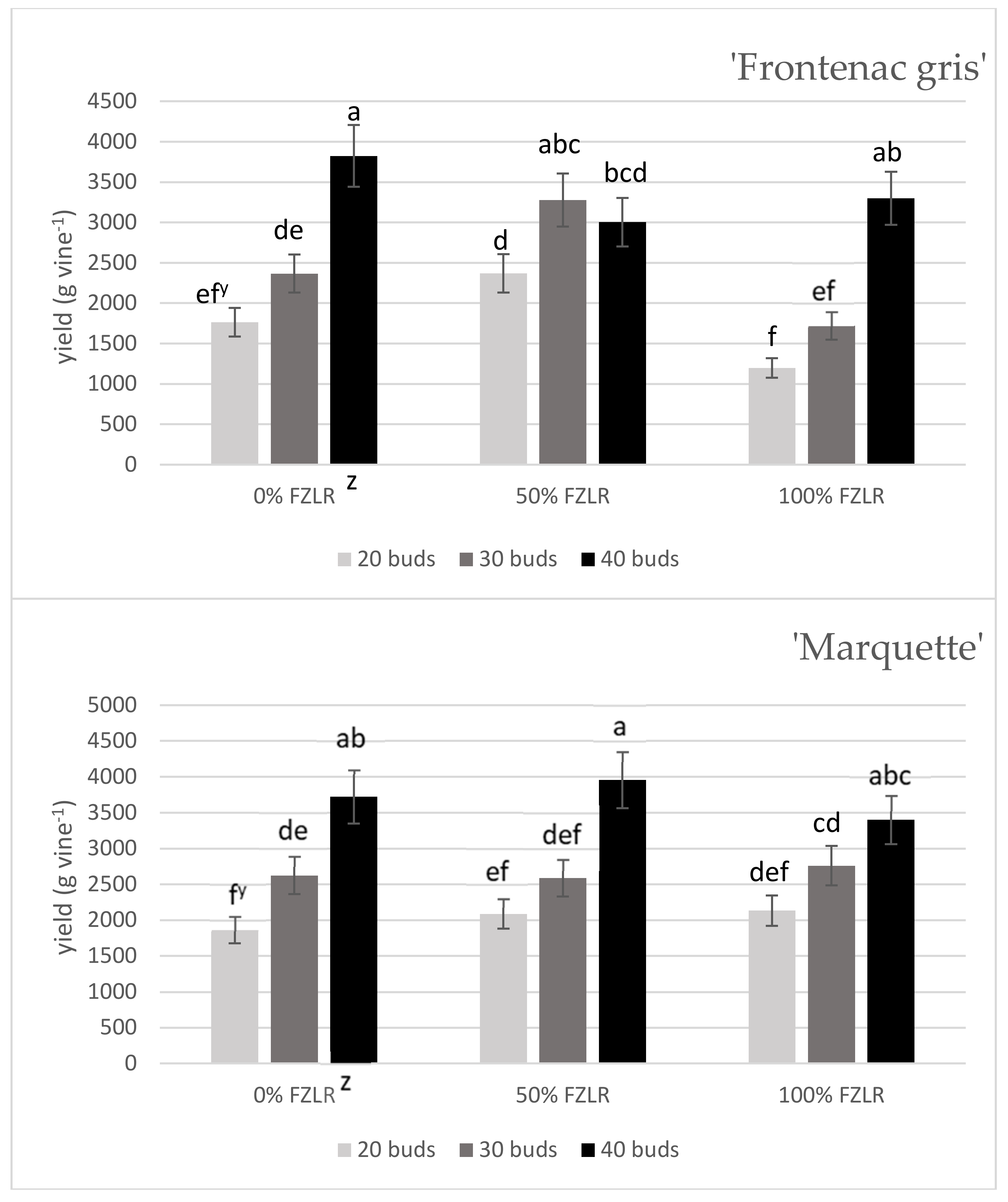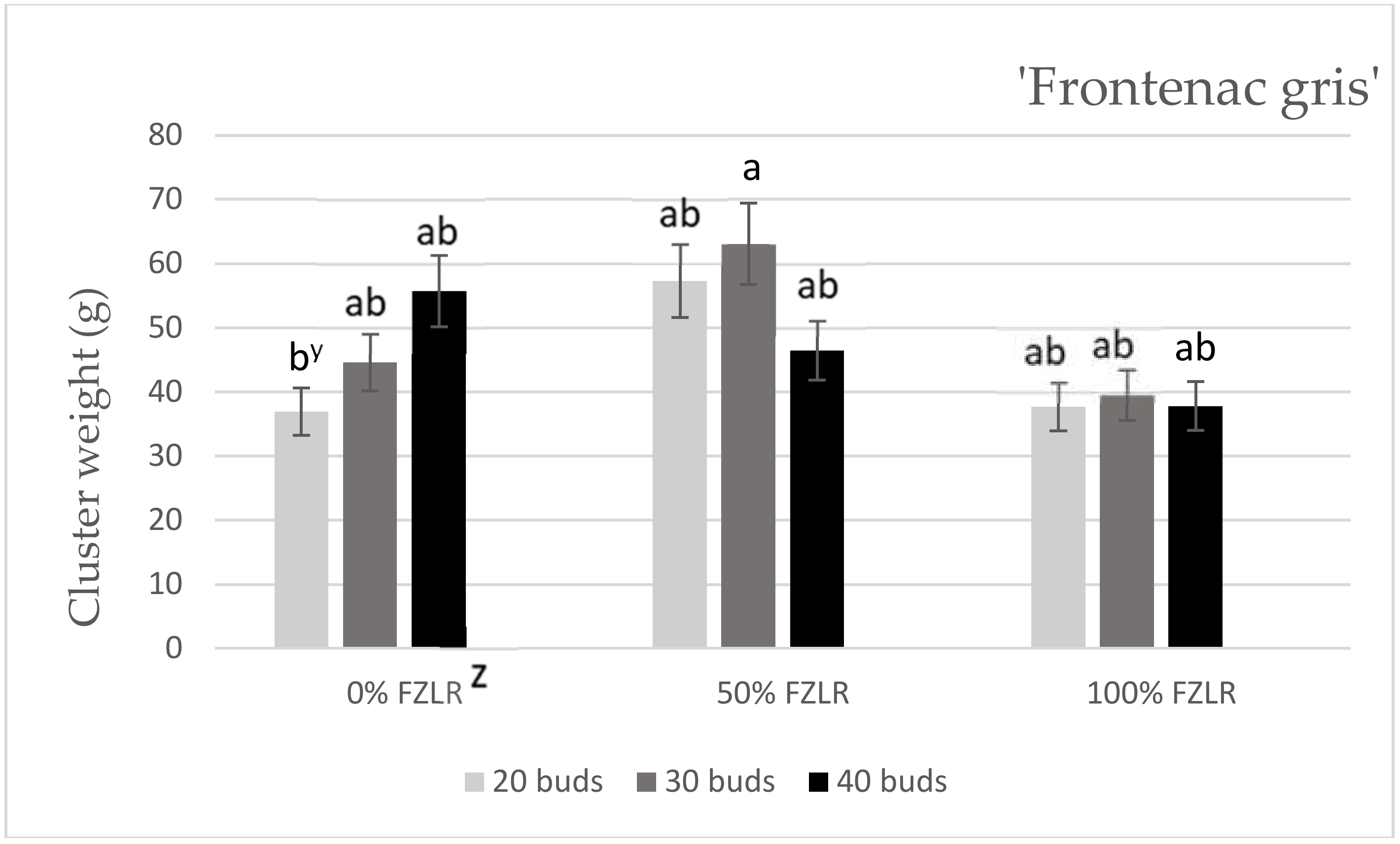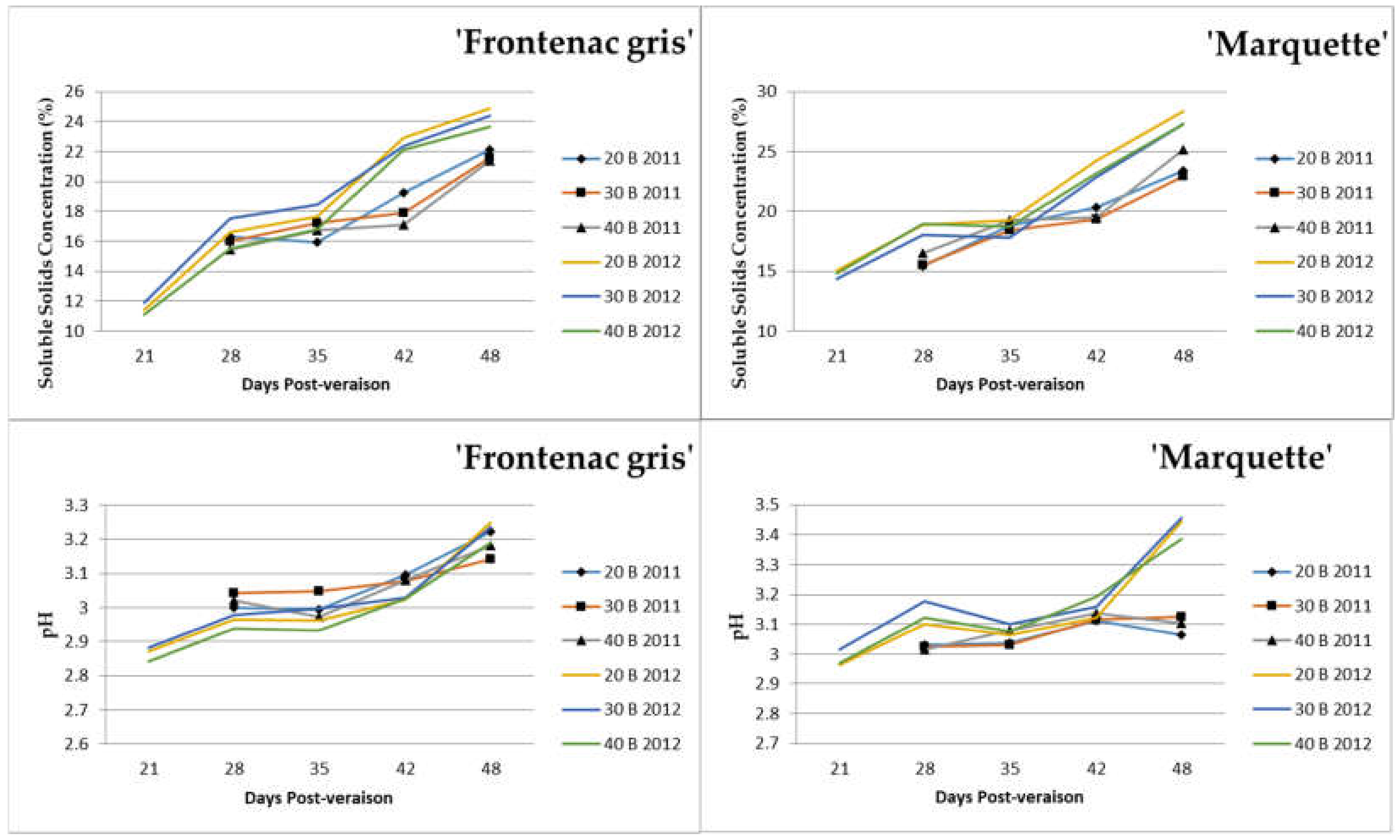1. Introduction
The development of cold, hardy,
Vitis riparia-based grape cultivars started a new industry in the northern Great Plains region. In North Dakota, the passing of farm winery legislation in 2001 signified the start of the grape and wine industry [
1]. These
V. riparia-based grape cultivars have enabled wine grape production in areas where
V. vinifera cultivars cannot survive winter low temperatures, but they also present new challenges as fruit development and fruit composition differs from
V. vinifera cultivars [
2,
3,
4]. One of the greatest challenges with
V. riparia-based cultivars in the northern Great Plains region is the high titratable acidity (TA) levels. Research is limited on viticulture methods to reduce high TA levels, especially under the short growing season and low accumulated heat units in the northern Great Plains region [
4].
Pruning is a critical part of grape production to control crop load and vine growth in order to manipulate crop yield and fruit quality [
5,
6,
7]. The influence of crop level on fruit quality with
V. vinifera cultivars is inconclusive, with similar reports showing a low crop load associated with high wine quality has no relationship between crop level and wine quality [
8,
9,
10]. Studies have determined the effect of crop level on specific cold-hardy grape cultivars, but these studies were conducted around the Great Lakes area, with longer growing seasons and milder winter conditions [
11,
12]. While the need for adequate vegetative growth has been recognized as it relates to sufficient carbohydrate production and in turn, full fruit ripening, the negative impact of over-cropping from delayed fruit maturity, compromised quality, and reduced winter hardiness can be exacerbated in cool climates [
13,
14]. Carbohydrates are necessary for shoot lignification and energy storage for overwintering, insufficient storage amounts detrimentally affect grapevine growth and overall health [
15]. Balanced pruning methods allow growers to better anticipate and control reproductive yield and achieve a sustainable balance of plant growth and yield within their vineyard.
In cold climate regions, limited accumulation of heat units during the growing season often leads to insufficient grape fruit ripening [
4]. Fruit-zone leaf removal has been shown to accelerate the soluble solids and flavonoid accumulation in
V. vinifera fruit by increasing the rate of berry ripening due to control of microclimate in warmer regions [
10,
16,
17,
18]. Increased rate of berry ripening may shorten the time to harvest and allow increased time for post-harvest carbohydrate accumulation within the vine prior to dormancy [
11]. Exposing fruit to high solar radiation, which increases the rate of grape berry ripening also has the potential to reduce disease incidence and increase grape quality at harvest in northern production regions [
4,
13,
19]. Adequate light to grape vine buds during floral development and differentiation is also critical for subsequent bud fertility and fruitfulness [
20,
21]. In cold climate conditions, the ability of a grapevine to overwinter is critical for consistent annual production. The objective of this study was to evaluate pruning levels and fruit-zone leaf removal levels for consistent yield and quality of Frontenac gris and Marquette in North Dakota.
4. Discussion
Average monthly air temperatures and rainfall along with accumulated growing degree day data for the three vineyards suggests greater variation between years than between locations. All three vineyards are located within the Red River Valley, one of three distinct geographical regions in North Dakota [
29]. The Red River Valley soil was formed from the sediment that settled out of the ancient glacial Lake Agassiz and is considered one of the most fertile soils in the world and extremely productive. Yearly variation of environmental conditions was most evident from the milder winter conditions, combined with slightly warmer spring conditions in 2012, compared to 2011 and to the 30-year average. As a result, vine bud swell and emergence from winter dormancy was earlier in 2012 compared to 2011. Earlier bud break and slightly warmer June and July temperatures in 2012 also led to earlier flowering, earlier fruit-zone leaf removal, and earlier veraison for both cultivars. Hatterman-Valenti et al. [
30] examined the growth and yield of 16 cultivars over a seven-year period and reported that cultivars showed no consistency for phenophases among years, indicating erratic spring climate conditions in the region. Similarly, Malheiro et al. [
31] showed the effects of temperature on phenology, especially how an increase in temperature during the spring will advance the timing of all phenophases.
One-year-old cane lengths were taken in an attempt to help explain plant vigor along with dormant pruning weights in response to crop load (primary bud retention levels). Previous research has shown that grapevines have adaptive response processes following differential cropping, such as reduced budburst, reduced fruitfulness, shorter shoots with closer internodes, increased yield, and lighter clusters with smaller berries [
32,
33,
34]. The current results were just the opposite, with the longest one-year-old canes from vines pruned to retain 40 buds, the highest crop load level. However, as Greven et al. [
33] identified, most of these studies were conducted only 1–2 years and needed 4–7 years to show the sustainability of node pruning regimes and the potential change in vine behavior. Marquettes’ consistently longer one-year-old canes at each crop load level averaged over three locations and two years compared to Frontenac gris suggests that Marquette is more vigorous than Frontenac gris under Red River Valley conditions.
Dormant pruning weights provide information on vine size and vigor when used with fruit production; they can help determine crop load to assist with the assessment of vine balance. The dormant pruning weight differences between years was expected primarily due to increased pruning and training in 2011, compared to pruning the previous year, and from the better growing conditions in 2010 compared to 2011. Grant et al. [
35] showed that even with cold-hardy hybrid grape cultivars; shoot growth can vary greatly with temperature differences during the growing season. Dormant pruning weights were approximately two to four times greater at each primary bud retention level for Marquette vines compared to Frontenac gris, reinforcing the suggestion that Marquette is more vigorous than Frontenac gris. Atucha et al. [
36] also noted the vigorous growth of Marquette in cool-climate conditions, particularly as lateral shoots, but did not have Frontenac gris in the cultivar comparison study.
Berries were sampled weekly to obtain fruit SSC and pH estimates toward the harvest indices winemakers desired. Data were averaged over locations, years, and the fruit-zone leaf removal percentages and over locations, years, and the number of retained primary buds. Graphs demonstrated how warmer growing conditions (higher average monthly air temperatures and greater AGDD) in 2012 compared to 2011 can hasten fruit ripening, especially for Marquette. Berry sampling at 48 days after veraison also reinforced fruit SSC and pH results at harvest.
Fruit yield differences were attributed to the primary bud retention level maintained throughout the growing season and that increased production was possible through the retention of more buds. Grape vines pruned to retain 20 primary buds produced the least amount of fruit with an average of 1903 g vine
−1 or 1294 kg ha
−1. Retaining an additional 10 buds increased the yield approximately 34% to 1739 kg ha
−1. Grape vines pruned to retain 40 primary buds were the highest yielding, with an average of 3534 g vine
−1 or 2403 kg ha
−1, an 86% yield increase by retaining twice as many buds. The only exception was Frontenac gris vines with 50% of the fruit-zone leaves removed. Other researchers have also shown that an increase in crop load will result in an increase in crop yield [
32,
33,
34]. However, Greven et al. [
33] showed how a vine will moderate yield over time in response to altered node number. They showed that increasing the number of nodes beyond 36 per vine (evaluated 24, 36, 48, 60, and 72 retained nodes per vine) for Sauvignon Blanc did not increase yield after the first year. This concluded that cane vigor and fruit clusters per vine are part of the mechanisms by which vines moderate yield over time in response to altered node number. Even though a longer study would have been beneficial for the determination of sustainability for the primary bud retention levels, the lack of a yield decrease the second year may suggest that the primary bud retention levels did not reach an over-cropping level, especially with the warmer growing conditions in 2012. Higher crop load levels would have helped to delineate over-cropping, but with severe winter dieback observed for Marquette vines in a cultivar trial the winter of 2009/2010 [
30], and the desire to not cause dieback to vines owned by growers in the area, selected primary bud retention levels may have been too similar to adequately define optimal crop load for the two cultivars.
Fruit-zone leaf removal influence on yield was not expected, as research with
V. vinifera cultivars showed yield reductions only when fruit-zone leaves were removed pre-flowering or at flowering [
37,
38]. Kosteridis et al. [
38] did show that post-flowering leaf removal decreased yield per vine and cluster weight in Merlot and Sangiovese. Scharfetter et al. [
19] reported numerical increases in yield per vine with fruit-zone leaf removal for several cold-climate interspecific hybrid cultivars, but the variability over the three years eliminated any leaf removal differences. None of the research on leaf removal had as short of a growing season or as low accumulated growing degree-days (AGGD) as reported in the current study and little research has examined carbon partitioning in response to fruit-zone leaf removal. Chanishvili et al. [
39] reported that the defoliation of a
V. vinifera cultivar created a powerful sink for assimilates, enhanced the photosynthetic activity of the remaining source leaves and redirected assimilate transport toward the defoliation zone, from the young leaves in particular. This is understandable for grapes grown in warm and hot environmental conditions, but the average monthly temperature for the three locations in July was 22 °C. Motomura [
40] showed that the growth of set berries until they reach at least 30%−40% of their final size, primarily relies on carbon assimilated by leaves right above and below the cluster. Frioni et al. [
41] showed that in the temperate climate of Michigan a severe level of Pinot Noir leaf removal (10 leaves) at flowering drastically decreased fruit-set and final yield. However, they could not explain why the removal of six basal leaves at flowering (removing 47% of the pending leaf area) had no significant effect on fruit-set or final yield. The lowest yield of Frontenac gris occurred with 100% fruit-zone leaf removal, suggesting that leaf removal may have been too severe for the less vigorous cultivar. Splitting the removal of six fruit-zone leaves into two timings may alleviate the low leaf number to fruit cluster ratio and increase carbohydrate synthesis during an important period of fruit development. However, it is unlikely that an additional leaf removal activity is economically feasible, since most vineyards in North Dakota are less than 2 ha and do not have a mechanical method for leaf removal.
Even though average cluster number differences could be explained simply by differences in bud numbers, average cluster weight was not related to bud retention numbers, suggesting that vines may have been able to support additional clusters if more buds had been retained. Both Marquette and Frontenac gris cluster mass averages were far below their recognized averages of 89 and 131 g per cluster, respectively, while berry masses were near their recognized average of 1.1 g per berry [
28]. Berry mass results were counter intuitive to previous research on carbohydrate reserves and pruning methods when yield limits have been reached [
6], reinforcing the earlier suggestion of greater bud retention to reach vine balance. Hatterman-Valenti et al. [
30] reported that over the span of seven years, Marquette and Frontenac gris cluster mass averages were 65 and 77 g cluster
−1, respectively, which were also below the recognized averages obtained by researchers at the University of Minnesota. These results suggest that the fewer GDDs and environmental conditions in North Dakota may limit fruit cluster size and production potential.
A higher SSC for Marquette in 2012 compared to 2011 was expected. Marquette is a late maturing cultivar and with the extended length of the growing season in 2012, more soluble solids were assimilated. Marquette SSC at harvest was near the recognized average harvest level of 25.7% [
28]. Riesterer-Loper et al. [
4] reported higher juice SSC in 2015, but not 2016, for Marquette vines with three fruit-zone leaves removed compared to no leaf removal. Authors attributed this difference to the delay in fruit harvest in 2015. Fruit was harvested two weeks later in 2015, but the AGGD at harvest was only slightly greater, at 1492 GDD in 2015 compared to 1421 GDD in 2016. Scharfetter et al. [
19] reported no differences in Marquette fruit SSC in response to fruit-zone leaf removal and speculated that this was due to the removal of only two to three cluster-shading leaves and that the positive effect of leaf removal on fruit composition at harvest only occurs in cool summers, when minimal thermal requirements for fruit maturation were not met. Similar fruit SSC for Frontenac gris in 2011 and 2012 was expected as Haggerty [
28] reported similar fruit SSC at harvest for Frontenac gris, but also suggested this was due to the accumulation of at least 1400 GDD each year. Scharfetter et al. [
19] also reported similar fruit SSC for Frontenac with and without fruit-zone leaf removal. Frontenac gris was derived as a sport of Frontenac and has been reported to carry many of the same vine growth and fruit chemistry characteristics as Frontenac [
42]. Frontenac gris fruit SSC at harvest was not near the recognized average of 26% at harvest, but it was still within the desired level for most wine styles [
13].
Haggerty [
28] reported that Frontenac gris and Marquette fruit pH profiles varied substantially among years and that a GDD model may not be useful in predicting acidity in the berry. Lack of fruit pH differences at harvest for either cultivar in the current study may suggest that primary bud retention levels, fruit-zone leaf removal levels and environmental conditions interacted or varied enough between the two years that fruit pH differences were not significant. Scharfetter et al. [
19] also reported no differences in Marquette fruit pH in response to a leaf removal treatment, while Riesterer-Loper et al. [
4] did not report fruit pH.
The lower TA level for Marquette fruit when 100% fruit-zone leaves were removed was expected and previously reported with V.
vinifera and cold-hardy cultivars [
19,
20]. However, Riesterer-Loper et al. [
4] reported that fruit-zone sunlight exposure did not affect Marquette TA levels. No study has evaluated the TA level for Frontenac gris in response to cluster sunlight exposure. One would assume that since Frontenac gris has been reported to carry many of the same vine growth and fruit chemistry characteristics as Frontenac [
43], and the effect of sunlight exposure to clusters has been variable for Frontenac fruit at harvest [
3,
15,
28], Frontenac gris fruit TA in response to fruit-zone leaf removal would also be variable. Haggerty [
28] reported that the highest average TA after 1400 GDD were Frontenac(18.2 g/L), Frontenac gris(16.8 g/L), La Crescent(15.2 g/L), and Marquette(12.3 g/L), and that of the cold-hardy hybrid cultivars, St. Pepin, Maréchal Foch, and Marquette were most like
V. vinifera cultivars in respect to TA.
These results suggest that for the two V. riparia-based wine grape cultivars used in this study, environmental conditions such as a shorter growing season and fewer GDDs in North Dakota may reduce the production potential by limiting cluster size without compromising most fruit quality parameters. Primary bud retention levels above those tested in the current study should be investigated for a longer period of time, in order to understand the impact of crop level on Frontenac gris and Marquette crop yield and fruit composition during the shorter growing season and fewer GDDs in North Dakota. Results also warrant further research into cultivar adaptiveness to northern Great Plains conditions and sunlight exposure manipulation to grape vines and fruit clusters. With further research, it is anticipated that wine grape cultivars and management practices will be identified to withstand the abiotic stresses in North Dakota and northern Great Plains, while still producing sustainable yields and acceptable fruit quality for commercial wine grape production.










